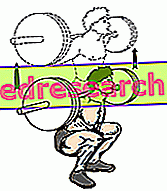by Roberto Eusebio, absolute national champion of body fitness
in collaboration with Di Bella Dario
Hands up who has never presented with a disturbing sense of anxiety at the most feared appointment of the week. Those who have been practicing body building for some time and with a minimum of seriousness and determination have already figured out what I'm talking about: I'm talking about leg training. Yes, because if in the other training sessions we sang victory on biceps and pectorals, triceps and so on, looking at ourselves in the mirror one, ten, a hundred times with satisfaction, now it's up to the legs, and with the legs you don't mess around anymore: that day has arrived on time.

Whether we like it or not, the legs are made up of such massive muscular bundles that they always require very high loads to reach a "volume" satisfactorily. So let's forget about our "strenuous" sereettes from ten to the horizontal press or the curl for hamstrings with a weight of 30 kilos. Hypertrophy for the muscles of the lower limbs requires load, load and still load. Until the limit of endurance but always far from the threshold of the accident. Basically, training your legs is almost a metaphor for life: knowing yourself and your limits as much as possible and patiently waiting for the results of our efforts. On a psychological level I see that patience is very often a plant that few people love to cultivate; everyone would like a magazine body easily and quickly. I also admit to having been repeatedly affected by the impatience virus, over months and years of training, but we must remember that in the practice of body building there is nothing easy and immediate, and this is because the body considers a luxury the increase in muscle mass that will later on nourish and oxygenate. It is no coincidence that a Ferrari pays a lot more tax than a small car, so if it's a Ferrari we want, let's get ready to work hard.
Personally, in the gym I don't like to try my hand at a large number of different exercises; my watchword has always been "simplify", favoring large multi-joint businesses at the expense of using machines or isolation exercises. Perhaps this is a legacy of when I was training fifteen years ago, in times when there was only the crude "body building" and there was still no talk of "fitness" and other refinements. However, I have nothing against the use of guided load machines, to which we can always return or resort to the end of the hard routine months based on old-style exercises, the main of which is certainly the free squat.
I consider the free squat the king of all multi-joint exercises, almost a kind of divinity that grants prizes or punishments depending on how you approach it. This is why mine is not a simple weekly squat session, but an almost sacred liturgy that I do not hide from going to each time with a certain fear. With the squat there are no terms; that feeling that you feel when you detach the barbell from the supports is unrepeatable: we seem to have a cubic meter of concrete that rests on the trapezoids. Well, that's where we need to go. The impalpable threshold, the stargate, is there: those who get scared and come back will get the results they deserve: mediocre. Those who have courage and continue will be rewarded by the squat god. Let's see how to structure a training session for the legs that is truly productive and non-dispersive:
We start the squat only after at least six months of strengthening the legs with other less complex and more specialized exercises like Leg Extension, oblique press, lunges, etc. Attention because, paradoxically, the exercises that seem harmless can have nasty surprises. In particular we keep the lower part of the back glued to the back of the oblique press: we will avoid playing with the lumbar. Let us not be deceived by the guided trajectory of the gym machines and the sense of security that they seem to convey.
We work a lot on the lumbar, without necessarily weighing ourselves down with ten-kilo discs held to the chest: four series of the 20-20-15-15 type are enough but performed consistently at least once or twice a week. Constancy is what counts. We do not overextend the bust, we do not exploit the rebounds, we do not hurry this useful exercise for care and desire to finish. Perhaps the lumbar will not be beautiful to look at, but they are and remain indispensable muscles. We do not neglect even the abdominals. Our ultimate goal is to erect a support belt that makes the back a sturdy "trunk" that can withstand the weight of the barbell. Work on the lumbar should never be stored in the drawer but continued even after the preparations have been completed.
I have often read wonders about another great multi-joint exercise: the deadlift with dead legs (deadlift). I tried it for months and I found that as much as we can commit to a correct execution, the mechanics are so unfavorable that sooner or later your back will be compromised at all levels. In my opinion the game is not worth the candle, also because the gap really takes a lot of weight to become productive, and at that point it has become too dangerous. In the absence of a trap bar, or square barbell, which should allow us to make the detachment safely but we will probably never have it, we therefore allow this exercise to be performed by the powerlift practitioners who, their goodness, perform it in a complete version.
Start the squat session after performing four sets of ten at the Leg extension with a light load in order to pre-congest the quadriceps. In the breaks between one series and the next I force myself not to start chatting but I do stretching exercises of hamstrings, quadriceps and calves. The calves have already worked first in the Calf sitting (4 sets of 10-12 repetitions) and at the Calf standing (2 sets of 30-50 repetitions). In the calf I look for the maximum possible articular excursion, even when it seems to slip off a cliff and the calves catch on pain. For all the muscles, but more than ever for the calves, the concept of genetic predisposition applies: in a nutshell, if we have few basic ones it will be much harder to see them grow. So let's not expect immediate progress for the calves; perhaps the best attitude is not to expect too much from this very difficult to develop muscular district. Any result will then be welcome.
second part "



